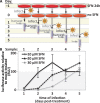Sulforaphane Inhibits HIV Infection of Macrophages through Nrf2
- PMID: 27093399
- PMCID: PMC4836681
- DOI: 10.1371/journal.ppat.1005581
Sulforaphane Inhibits HIV Infection of Macrophages through Nrf2
Abstract
Marburg virus, the Kaposi's sarcoma-associated herpesvirus (KSHV) and Dengue virus all activate, and benefit from, expression of the transcription regulator nuclear erythroid 2-related factor 2 (Nrf2). The impact of Nrf2 activation on human immunodeficiency virus (HIV) infection has not been tested. Sulforaphane (SFN), produced in cruciferous vegetables after mechanical damage, mobilizes Nrf2 to potently reprogram cellular gene expression. Here we show for the first time that SFN blocks HIV infection in primary macrophages but not in primary T cells. Similarly SFN blocks infection in PMA-differentiated promonocytic cell lines, but not in other cell lines tested. siRNA-mediated depletion of Nrf2 boosted HIV infectivity in primary macrophages and reduced the anti-viral effects of SFN treatment. This supports a model in which anti-viral activity is mediated through Nrf2 after it is mobilized by SFN. We further found that, like the type I interferon-induced cellular anti-viral proteins SAMHD1 and MX2, SFN treatment blocks infection after entry, but before formation of 2-LTR circles. Interestingly however, neither SAMHD1 nor MX2 were upregulated. This shows for the first time that Nrf2 action can potently block HIV infection and highlights a novel way to trigger this inhibition.
Conflict of interest statement
The authors have declared that no competing interests exist.
Figures








Similar articles
-
Sulforaphane Reduces SAMHD1 Phosphorylation To Protect Macrophages from HIV-1 Infection.J Virol. 2022 Dec 14;96(23):e0118722. doi: 10.1128/jvi.01187-22. Epub 2022 Nov 15. J Virol. 2022. PMID: 36377871 Free PMC article.
-
Sulforaphane Inhibits Lipopolysaccharide-Induced Inflammation, Cytotoxicity, Oxidative Stress, and miR-155 Expression and Switches to Mox Phenotype through Activating Extracellular Signal-Regulated Kinase 1/2-Nuclear Factor Erythroid 2-Related Factor 2/Antioxidant Response Element Pathway in Murine Microglial Cells.Front Immunol. 2018 Jan 23;9:36. doi: 10.3389/fimmu.2018.00036. eCollection 2018. Front Immunol. 2018. PMID: 29410668 Free PMC article.
-
Synergy between sulforaphane and selenium in protection against oxidative damage in colonic CCD841 cells.Nutr Res. 2015 Jul;35(7):610-7. doi: 10.1016/j.nutres.2015.05.011. Epub 2015 May 30. Nutr Res. 2015. PMID: 26094214
-
Anticancer Activity of Sulforaphane: The Epigenetic Mechanisms and the Nrf2 Signaling Pathway.Oxid Med Cell Longev. 2018 Jun 6;2018:5438179. doi: 10.1155/2018/5438179. eCollection 2018. Oxid Med Cell Longev. 2018. PMID: 29977456 Free PMC article. Review.
-
Sulforaphane - role in aging and neurodegeneration.Geroscience. 2019 Oct;41(5):655-670. doi: 10.1007/s11357-019-00061-7. Epub 2019 Apr 2. Geroscience. 2019. PMID: 30941620 Free PMC article. Review.
Cited by
-
Activation of NRF2 blocks HIV replication and apoptosis in macrophages.Heliyon. 2022 Dec 23;9(1):e12575. doi: 10.1016/j.heliyon.2022.e12575. eCollection 2023 Jan. Heliyon. 2022. PMID: 36691556 Free PMC article.
-
Potential of Sulforaphane as a Natural Immune System Enhancer: A Review.Molecules. 2021 Feb 1;26(3):752. doi: 10.3390/molecules26030752. Molecules. 2021. PMID: 33535560 Free PMC article. Review.
-
Sulforaphane Reduces SAMHD1 Phosphorylation To Protect Macrophages from HIV-1 Infection.J Virol. 2022 Dec 14;96(23):e0118722. doi: 10.1128/jvi.01187-22. Epub 2022 Nov 15. J Virol. 2022. PMID: 36377871 Free PMC article.
-
Analysis of Early Phase HIV-1 Replication and Integration Events by Using Real-time PCR.Bio Protoc. 2019 Feb 20;9(4):e3168. doi: 10.21769/BioProtoc.3168. eCollection 2019 Feb 20. Bio Protoc. 2019. PMID: 33654974 Free PMC article.
-
Interleukin-17D and Nrf2 mediate initial innate immune cell recruitment and restrict MCMV infection.Sci Rep. 2018 Sep 12;8(1):13670. doi: 10.1038/s41598-018-32011-2. Sci Rep. 2018. PMID: 30209334 Free PMC article.
References
-
- Gartner S, Markovits P, Markovitz DM, Kaplan MH, Gallo RC, Popovic M. The role of mononuclear phagocytes in HTLV-III/LAV infection. Science. 1986;233(4760):215–9. Epub 1986/07/11. . - PubMed
Publication types
MeSH terms
Substances
Grants and funding
LinkOut - more resources
Full Text Sources
Other Literature Sources
Research Materials
Miscellaneous

